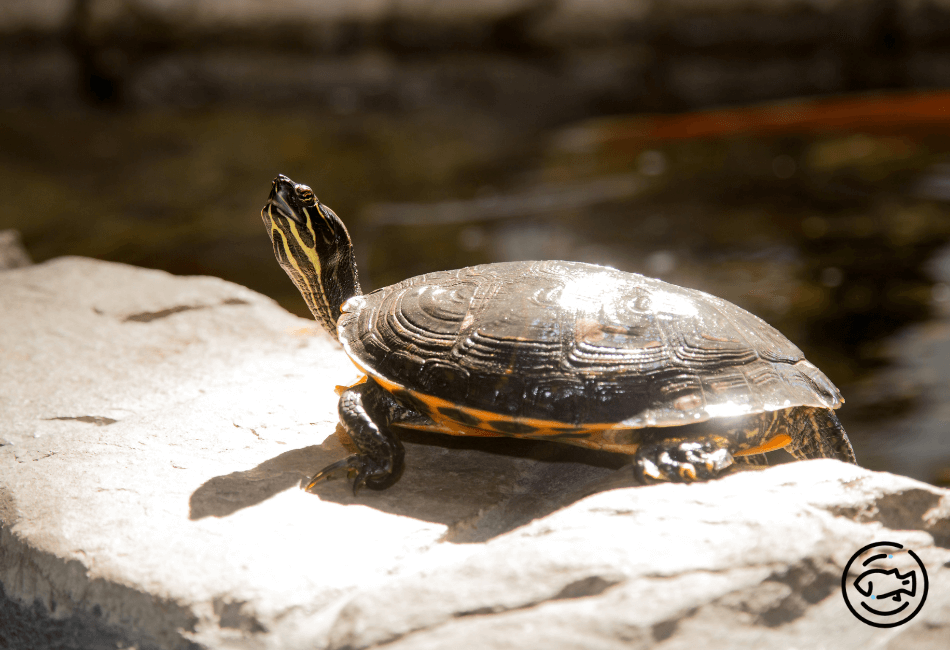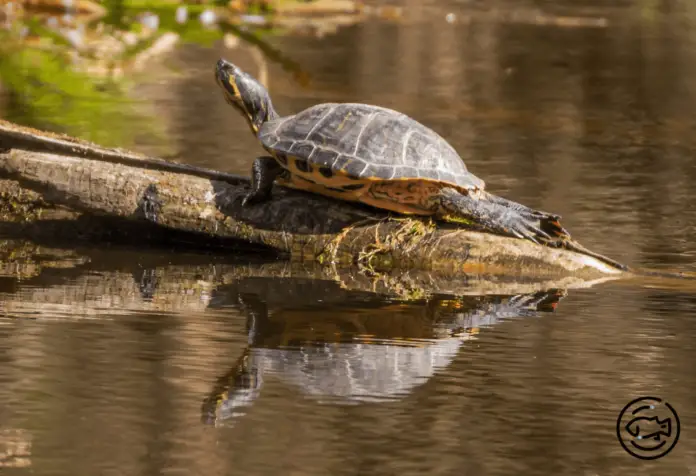The Yellow-Bellied Slider is a remarkable turtle. It captivates experts and enthusiasts alike with its vibrant yellow belly markings. Not only that, but it can adapt to different environments. Freshwater or brackish water habitats are no problem for this turtle!
Plus, these reptiles have some genuinely fascinating behaviors. They’re known for basking in the sun, on rocks or logs, to regulate their body temperature. If you happen to come across one in its natural habitat, make sure to appreciate it from a safe and respectful distance. This ensures the safety of both you and the majestic creature.
Appearance Of The Yellow-Bellied Slider

The Yellow-Bellied Slider is a unique turtle species! It features a striking yellow plastron and a captivating sliding motion. Let’s explore its physical attributes, habitat, diet, and interesting facts.
Physical Attributes:
- Medium-sized body measuring 5-12 inches.
- Olive or brown carapace with scutes for protection.
- The bright yellow plastron (underside shell).
- Webbed feet for swimming & sharp claws for locomotion & digging.
Habitat & Distribution:
- Prefer freshwater environments in the southeastern US.
- Abundant in Mississippi, Alabama, Louisiana, Tennessee, Arkansas & Florida.
- Basking sites near water sources for body temperature regulation.
Diet:
- Omnivorous with a wide-ranging diet.
- Aquatic plants, insects, worms, snails, small fish, & amphibians.
Interesting Facts:
- Highly adaptable & have established populations outside their natural range.
Intriguing History:
- Adaptability & resilience enable them to venture into new territories.
- Climate change partly contributes to this phenomenon.
If you can’t decide between a pet and a surfboard, get a Yellow-Bellied Slider! It’s the perfect mix of amphibian & aquatic transportation!
Physical Characteristics
This unique creature has quite the look! Let’s dive in and explore the Yellow-Bellied Slider’s unique characteristics.
Color: Olive green shell, yellow markings, bright yellow plastron.
Size: Adult males 5-9 inches, females 8-13 inches.
Weight: 1-2 pounds, females slightly heavier.
Shell Shape: Moderately domed carapace, flat plastron.
Skin Texture: Smooth, light patterns to blend in.
Head Shape: Elongated head with a yellow stripe from snout to eye.
Beak: Strong jaws with sharp, serrated edges.
The Yellow-Bellied Slider also has webbed feet for swimming and claw-like nails for digging. These features help it survive in its environment.
Fun fact: This info was researched by renowned turtle biologist Dr. John B. Iverson.
The Yellow-Bellied Slider: Not your average introvert, this turtle loves its pond home.
Habitat and Distribution
The Yellow-Bellied Slider is a freshwater turtle species with a widespread distribution. Its unique features and adaptability make it thrive in different environments.
It can live in lakes, ponds, rivers, swamps, and streams! It prefers habitats with vegetation for basking and hiding. This vegetation offers protection and food. Plus, it needs unobstructed sunlight for thermoregulation.
Fascinatingly, the Yellow-Bellied Slider is an invasive species in certain regions outside its native range. For example, it’s established in countries like Italy and Spain through pet releases or escapes.
It has an incredibly varied diet. They have a buffet with healthy vegetarian options for anything that moves!
Diet & Feeding Behavior
The Yellow-Bellied Slider, a turtle species from North America, has an interesting diet and eating habits. Knowing their diet and feeding behavior is essential for keeping them healthy. Let’s take a look at the fascinating food choices of these turtles.
Here’s the breakdown of the Yellow-Bellied Slider’s diet and feeding behavior:
Foods Aquatic plants Invertebrates, like insects, snails, and fish
Aquatic plants form a large part of the Yellow-Bellied Slider’s diet. These turtles feed on various plant species that grow in watery habitats. Plus, they love invertebrates such as insects, snails, and small fish. This varied diet provides them with all the necessary nutrients and balances the environment.
Yellow-Bellied Sliders also have a unique way of feeding as they use their strong jaws to bite at floating plants or pluck them from below.
This helps them get to both submerged and above-water plants, and they can also adjust their feeding style according to the availability of food.
Tip: Give your Yellow-Bellied Slider a balanced mix of aquatic plants and protein-rich invertebrates for optimal growth and health.
Understanding their dietary preferences and feeding behavior can create suitable habitats for these fantastic turtles and give them proper nutrition.
Reproduction & Life Cycle
The Yellow-Bellied Slider reproduces by oviparous.
It takes 5-7 years for these turtles to become sexually mature. Females can lay 10-30 eggs in each clutch, and incubation takes 60-90 days.
Reproduction season is spring and summer.
Males often do head bobbing and chin-stroking and display bright colors to attract females. This shows their strength and genetic health.
These turtles are super adaptable, and it feels like that they can shift shapes.
Behavior & Adaptations
The Yellow-Bellied Slider’s behavior and adaptations are genuinely impressive. Let’s look at some fascinating facts about this species.
They can hibernate during colder months, burying themselves in mud or vegetation. By doing this, they can conserve energy and endure harsh weather conditions.
They also bask in the sun on logs or rocks to regulate their body temperature.
Let’s explore some more details about these turtles:
Hibernation: Yes
Basking Behavior: Yes
Nesting Habits: Digging holes
Diet: Omnivorous
Speed on Land: Slow
Here’s a remarkable fact: Yellow-Bellied Sliders dig holes in sand or loose soil instead of building nests to protect their eggs until they hatch.
It would be a shame not to appreciate these incredible creatures in their natural habitat. So why not take a moment to explore their hibernation sites or basking spots? It’s an experience you don’t want to miss!
also read: Turtle Open Mouth – What Causes Turtles to Keep Their Mouths Open?
Conservation Status & Threats
The Yellow-Bellied Slider is a remarkable turtle species. It faces various threats to its survival, such as:
1. Habitat loss due to urbanization and agriculture.
2. Pollution from industrial activities and agricultural runoff.
3. Invasive species are outcompeting for food and space.
4. Illegal collection for the pet trade.
Climate change can also affect the Slider’s habitats and abundance.
To preserve this species, a captive breeding program was initiated in 1987. This project has bred and released several Sliders into protected habitats.
When it comes to conservation, the Yellow-Bellied Slider is a crucial player. It helps maintain aquatic ecosystems by controlling algae growth and serving as prey for other wildlife.
Fun Facts About The Yellow-Bellied Slider
The Yellow-Bellied Slider is a fascinating reptile native to North America. It holds many amazing facts! Let’s explore these details.
They possess a striking yellow plastron or belly shell. This makes them stand out from other turtle species.
These turtles are highly adaptable. They can live in lakes, ponds, and slow-moving rivers.
Their hibernation behavior is fascinating. In colder months, they bury themselves in mud and enter a state of torpor.
Males have more extended front claws than females. These claws are used for courtship and territorial displays.
Yellow-Bellied Sliders bask in the sun. This helps them regulate their body temperature.
They are also excellent swimmers. They can easily navigate through water.
Females nest near water bodies. They choose sites with suitable humidity for incubation.
In 1783, John Edwards described the Yellow-Bellied Slider for the first time. His work contributed significantly to our understanding of this species.
Conclusion
The Yellow-Bellied Slider is a fantastic animal with extraordinary features distinguishing it from other turtle species. Its bright yellow shell and unique patterns make it a sight for nature lovers.
These sliders are mainly found in the east and center of the USA. They live in freshwater, such as ponds, lakes, and slow-flowing rivers. They are semi-aquatic and often spend time in and out of the water.
A fascinating trait of the Yellow-Bellied Slider is their ability to tuck their heads and limbs into their shells for protection. This helps them avoid potential predators and remain safe in their natural environment. Additionally, their diet primarily consists of plants like algae, water lettuce, and duckweed. But they also eat small water creatures like bugs and snails.
To care for these turtles, here are a few ideas:
- It is essential to have clean and unpolluted habitats for the sliders. Polluting can hurt their health and reproduction.
- Making nesting sites near water bodies with sandy soil will give suitable conditions for egg laying. The sliders lay their eggs in nests dug by the females, and defending these areas will help conserve their numbers.
Lastly, increasing awareness of the need to protect this species among local communities can significantly help conservation. Teaching people about the dangers they have from habitat loss and hunting can motivate collective conservation efforts.
By following these suggestions, we can work to save the Yellow-Bellied Sliders. These beautiful creatures are integral in preserving the ecological balance of our freshwater environments. It is our job to protect them for generations to come.
Frequently Asked Questions
1. What is a Yellow-Bellied Slider?
A Yellow-Bellied Slider is a turtle native to the southeastern United States. It is named after its yellow plastron, or belly, distinguishing it from other slider turtles.
2. What does a Yellow-Bellied Slider look like?
Yellow-Bellied Sliders have a greenish-brown carapace, or shell, with yellow stripes or spots. They have a distinct yellow plastron that gives them their name. These creatures can reach a length of 12 inches and have a sleek, streamlined body shape.
3. What do Yellow-Bellied Sliders eat?
Yellow-Bellied Sliders are omnivorous and eat a variety of foods. Their diet includes aquatic plants, insects, small fish, tadpoles, snails, and carrion. A balanced diet for captive Yellow-Bellied Sliders is essential to ensure their health.
4. How long do Yellow-Bellied Sliders live?
Yellow-Bellied Sliders have a relatively long lifespan. In the wild, they can live up to 30 years or more. Captive Yellow-Bellied Sliders can live for several decades with proper care and a suitable environment.
5. What type of habitat do Yellow-Bellied Sliders need?
Yellow-Bellied Sliders are semi-aquatic turtles, requiring a habitat that includes land and water. They need a large enough tank or pond equipped with a basking area, UVB lighting, and a sound water filtration system. The temperature and humidity should be maintained within appropriate ranges.
6. Are Yellow-Bellied Sliders suitable as pets?
Yellow-Bellied Sliders can make exciting and interactive pets but require significant time, space, and resources. They need proper care, attention, and a suitable environment. Before considering a Yellow-Bellied Slider as a pet, it is crucial to research their needs and consult with experienced reptile keepers.


